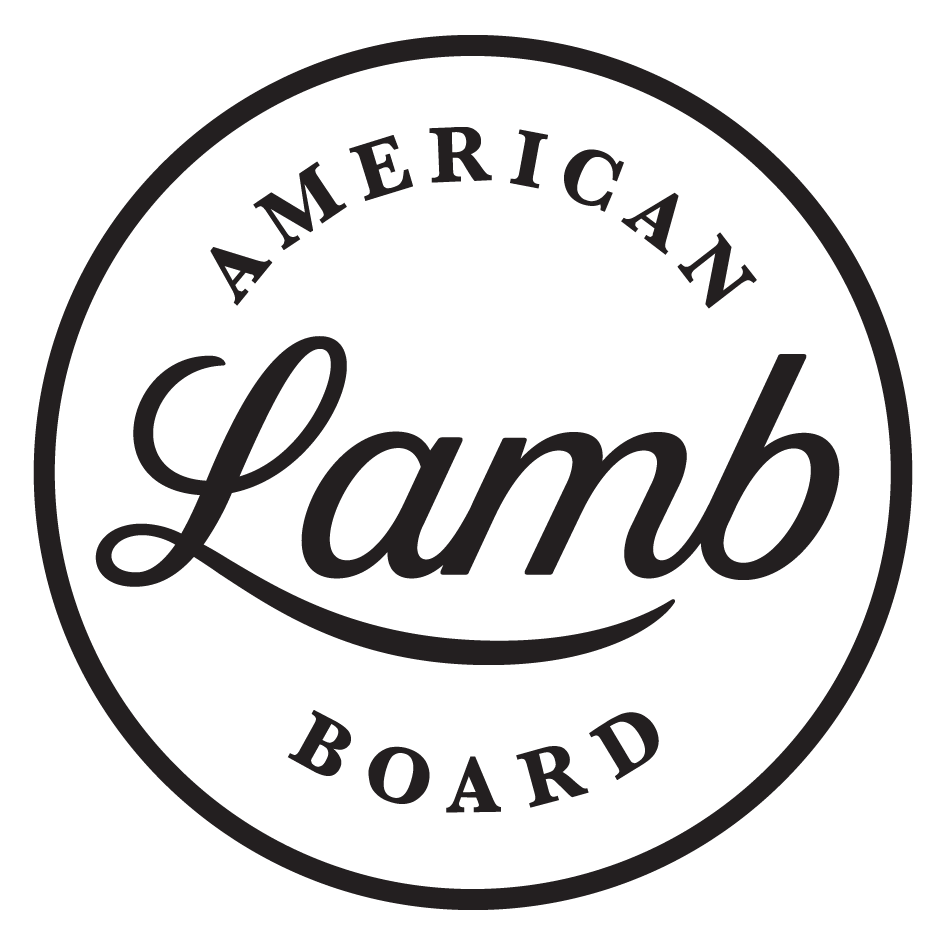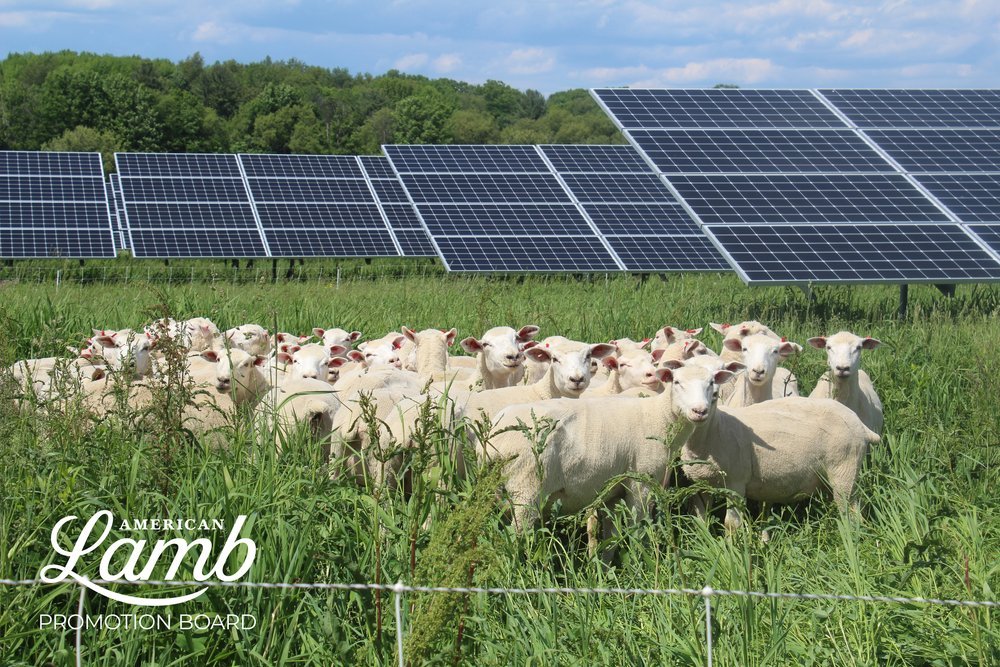Beneath the Panels: Sharing American Lamb's Solar Grazing Story
American Lamb's story goes beyond the care provided by the people who raise it. The next chapter includes how American Lamb contributes to regenerative land management through grazing practices, especially around solar farms. The American Lamb Board (ALB) is sharing this solar grazing story with consumers and supply chain partners to provide insight to the environmental stewardship of raising sheep.
“We’re dedicated to telling all components of the American Lamb story,” says Peter Camino, ALB chair from Buffalo, WY. “Sheep provide environmental benefits and support solar energy by improving solar farmland through the practice of grazing."
Today, solar power is more affordable, accessible and prevalent in the United States than ever before. It is projected to account for 20% of electricity generation in the U.S. by 2050. At the same time, farmland in America is shrinking and solar panels pepper the landscape, leaving that land largely unusable for other purposes. However, the livestock industry, specifically the sheep industry, has come to the rescue and the practice of solar grazing is gaining traction across the U.S., offering an environmentally friendly way to manage grass and weeds on solar farms.
Grazing sheep alongside solar operations offers benefits to both the land and animals. The sheep graze on grass and weeds, preventing vegetation from shading the solar panels or inhibiting their movement and reducing the need for manual landscaping such as mowing and pesticide use. In turn, the land is a food source for the sheep and the solar panels offer shelter from rain, wind and direct sun.
Using sheep to graze solar sites is gaining popularity as a successful and cost-effective strategy for vegetation control. It is less labor-intensive than traditional landscaping and improves the quality of the land by cycling nutrients back into the soil, minimizing erosion and encouraging native plant growth. Sheep can easily maneuver around and beneath the solar panels, grazing all parts of the land, eating grass, legumes, brush and weeds.
Here is a brief look at three operations across the country showcasing the diverse and impactful solar grazing efforts nationwide.
Richard “Rusty” Cocke of Southwest Lambscaping (Arizona)
Arizona, known for its desert landscape and abundant sunlight, has become home to many solar farms. As a sixth-generation rancher in Arizona and the great-great-great-grandson of famed rancher Henry Hooker, Richard “Rusty” Cocke recognized the opportunity for his sheep operation to improve land used by solar farms.
Weed control can be a major challenge for solar operations because weeds can obstruct the panels, reducing energy production, and weed overgrowth can even damage panels. Some solar operations use mowers and herbicides to control vegetation growth. When Arizona solar farms needed a more cost-effective and environmentally friendly solution to weed control, Cocke approached them with a solar grazing solution that would reduce the costs of solar energy production and provide a natural approach for weed control. He now has approximately 250 sheep grazing on solar farms in Arizona.
“If you think about it, this symbiotic relationship brings together one of the oldest agricultural practices with one of the newest energy technologies,” said Cocke. “We’re reducing the cost of solar energy, improving the quality of the land and raising lamb as a delicious and nourishing food source for American families. As a rancher, this just makes sense for us.”
Cocke notes the sheep eat a varied diet, which makes them well-suited to manage vegetation beneath solar panels. For example, desert tumbleweeds can be a major issue for solar farms, but they are a high-protein foodsource for sheep.
Trent Hendricks of Cabriejo Ranch (Missouri)
At the age of 10, Trent Hendrick’s father bought him his first ram and 50 ewes, and he’s been raising lamb ever since. But his passion didn’t start there, raising lamb was something he was born into, with his family raising sheep well before Hendricks took his first steps.
Today, Hendricks and his wife, Rachel, along with their six children, run Cabriejo Ranch in the Missouri Ozarks where they produce grass-fed beef and lamb and run a large solar grazing operation across the Midwest and Southeast states as part of their regenerative land and vegetation management services.
Hendricks didn’t initially set out to start a solar grazing business, but an opportunity came knocking when a large solar company approached him to manage their land with environmental benefits beyond just keeping the grass short. They wanted to implement regenerative agriculture practices to restore ecosystems, sequester carbon, restore soil health and improve water quality. Today, his solar grazing operation focuses on large-scale solar sites where he “follows the grass,” with sheep grazing mainly from April or May through Thanksgiving, before they come home to lamb during the winter months.
At the heart of his solar grazing operation, there’s a strong focus on stewardship.
“We've been given an opportunity to live on the land and work with livestock. And so, our goal is to be the best stewards of that gift,” says Hendricks.
Like many American Lamb farmers and ranchers, Hendricks’ passion for what he does drives how he does it,
“Grazing our sheep on the solar fields helps the land and the animals; the way we run our operation is done with a lot of heart and humility," said Hendricks. "We are constantly learning and working to improve what we do, and so are most farmers and ranchers. We are stewards of these animals, and we take that seriously.”
Judy St. Leger, DVM, of Dutch Barn Farm
After purchasing a historic farmstead in the Mohawk River Valley of New York, Judy St. Leger and her husband set out to improve the quality of the land. She brought in sheep and goats to graze, starting with just six and growing to her current flock of 250.
Knowing that agricultural land was shrinking and looking for opportunities to benefit her community, she got into the targeted grazing business, grazing first on nonherbicide cemeteries before a friend introduced her to solar grazing. She typically grazes her sheep in upstate New York from the beginning of May to the end of October.
As a veterinarian, St. Leger understands the unique symbiotic relationship between sheep and solar fields. The fields offer a protected area for sheep to graze, shade during the hottest part of the day, and plenty of vegetation to munch on. Sheep keep the vegetation low, protecting the solar panels from shade and cycling nutrients back into the soil.
For St. Leger, it’s all about the sheep having a high quality of life every day and supporting farms that are doing the best they can for the animals.
“With agricultural lands shrinking, anywhere we can bring agriculture alongside other industries to benefit the land and keep agriculture sustainable is good,” says St. Leger. “If we can use solar grazing as a way to expand the sheep industry in the U.S. and change profitability for farmers in a way that improves the land, then I think it’s a win-win situation.”
The Way Ahead
Across the country solar grazing operations look slightly different, from the time of year to the type of vegetation that needs management. What is clear is the mutually beneficial relationship between sheep and solar energy may hold the power to support food, fiber and energy production in an environmentally responsible way. American Lamb producers through collaboration and a focus on the entire ecosystem are shepherding a new way of thinking about the future of sheep and energy production.
ALB is an industry-funded national research, promotion and information checkoff program that works on behalf of all American producers, feeders, seedstock producers, direct marketers and processors to build awareness and demand for American Lamb. ALB conducts promotion and research programs with the goal of creating greater demand and profitability for the entire industry. One of its long-term goals is to collaborate and communicate with industry partners and stakeholders to expand efforts to grow, promote, improve and support American Lamb.

